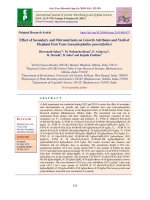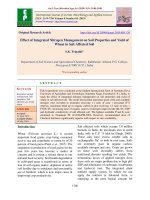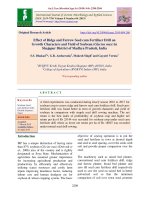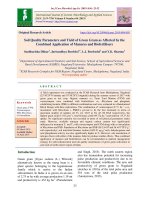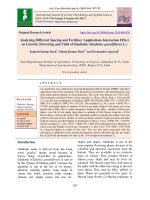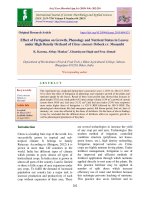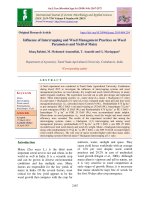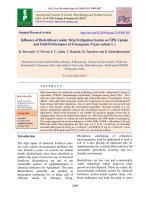Impact of bio-fertilizer on growth parameters and yield of potato
Bạn đang xem bản rút gọn của tài liệu. Xem và tải ngay bản đầy đủ của tài liệu tại đây (200.19 KB, 8 trang )
Int.J.Curr.Microbiol.App.Sci (2017) 6(5): 1717-1724
International Journal of Current Microbiology and Applied Sciences
ISSN: 2319-7706 Volume 6 Number 5 (2017) pp. 1717-1724
Journal homepage:
Original Research Article
/>
Impact of Bio-fertilizer on Growth Parameters and Yield of Potato
Morajdhwaj Singh, S.K. Biswas*, Devesh Nagar, Kishan Lal and Jaskaran Singh
Department Of Plant Pathology, Chandra Sekhar Azad University of Agriculture and
Technology, Kanpur, 208002, Uttar Pradesh, India
*Corresponding author
ABSTRACT
Keywords
Bio-fertilizers,
Azotobacter,
Potato, Growth
parameter, Yield.
Article Info
Accepted:
17 April 2017
Available Online:
10 May 2017
Application of different bio-fertilizers alone or in combination with others as seed, soil and
foliar spray revealed that the bio-fertilizers have stimulatory effect on germination,
sprouting behaviour and growth parameter of potato. The maximum germination and
number of bud with 5 in number per tuber was recorded from T 7 treatment in which
treatment was given as soil application FYM @ 150gm/pot + Mustard cake @ 150
gram/pot + tuber treatment with T. viride + foliar spray with bio-formulation of T. viride.
It was also cleared that bio-fertilizers have stimulatory effect on vigour of plants. The
maximum plant height was recorded in treatment T 7 (soil application of mustard cake +
tuber treatment and foliar spray with T. viride) with the value of 11.16cm at 30 day age of
plant followed by treatment T 4 (soil application of mustard cake + tuber treatment and
foliar spray with Azotobacter), T1 (soil application of neem cake + tuber treatment with
PSB), representing value of 11.06cm and 10.73cm, respectively. The effect of seed
treatment and foliar spray with bio-fertilizer on tuber size and yield was recorded that
maximum number of large size tubers (5) and yield (844.85gm) was found in T 7 treatment,
where treatment was given as soil application FYM @ 150gm/pot + mustard cake
@150gm/pot + tuber treatment with T. viride + foliar spray with bio-formulation of T.
viride
Introduction
Potato (Solanum tuberosum L.) is being a
high yielding, nutrient exhaustive and short
duration crop needs higher quantities of
fertilizers and pesticides as compare to other
crops. A normal potato crop yielding 30 t/ ha
removes about 100 kg N/ ha from soil
(Pandey et al., 2006). Nitrogen and
phosphorus are the major nutrients need in
potato cultivation along with potassium.
However, continuous and excessive use of
chemical fertilizers is causing ecological and
health hazards as well as deteriorating the soil
health resulting decline in crop yields. Under
these circumstances, organic sources play a
vital role in improving the soil fertility and
productivity of crop. The bio-fertilizers viz.
Azotobactor, Phosphobacteria and Bacillus
have been recognized as cheapest fertilizer
input for improving soil health and fertility
for optimum crop production. However, their
effects depend on types of the crops, soil and
environmental conditions. Singh, (2001)
reported that the ability of Azotobacter and
Phosphobacteria to proliferate in the
rhizosphere of crop suggests an increased
nutrient availability to the plants. Pfeiffer,
(1984) reported that defined biodynamic
approach as working with the energy from
1717
Int.J.Curr.Microbiol.App.Sci (2017) 6(5): 1717-1724
cosmos, earth, cow and plants are
systematically and synergistically harnessed,
which create and maintain life. Pathak, and
Ram. (2005) reported that the application of
biodynamic with compost or field sprays
(BD) gave higher yield and better return in
vegetables. Considering above point in view,
the study was undertaken in the present study
as “Impact of Bio-fertilizer on growth
parameters and yield of potato”.
Materials and Methods
Effect of different bio-fertilizers on
germination and growth parameters of
potato
Tuber seed treatment
The packets of Azotobacter containing 200gm
inoculum were obtained from Department of
Soil Science (Microbiology), Chandra
Shekhar Azad University of Agriculture and
Technology Kanpur. The seed tubers of
potato variety Kufri Sindhuri was used to
conduct the experiment. Seed tubers were
treated with Azotobacter @ 2g/10g of tuber
seed. 10gm Jaggery was also added to make
slurry and mixed it with seed tuber (Biswas et
al., 2016). Then the tubers were kept in shade
for dry.
On the other hands, seed tubers were also
treated with formulation of neemcake,
mustard cake @ 25% and bio-formulation of
Trichoderma viride, Trichoderma harzianum
and phosphorus solubilising bacteria @
2g/10gm of the tuber seeds. The seed tubers
were treated by dipping the tuber in prepared
solution separately. The treatments were
given for 2 hours before the sowing of tuber.
Germination and growth parameters of
potato
The experiment was conducted in the Glass
house complex, Department of Plant
Pathology, C.S.A. University of Agriculture
and Technology, Kanpur. The 30cm earthen
pots were used to conduct the experiment.
The pots were previously filled with a mixture
of sterilized sandy loam soil and farm yard
manure in the ratio of 2:1. In each pot, 1 seed
tuber was sown and watered as per need base.
The details of the treatments were given as
below:T1 = Soil application FYM @150gm/pot +
neem Cake @150gm/pot + tuber treatment
with T. harzianum + foliar spray with bioformulation of T. harzianum
T2 = Soil application with FYM @150
gm/pot + Tuber treatment with PSB + foliar
spray with bio-formulation of PSB
T3 = Soil application FYM @150gm/pot +
tuber treatment with Azotobacter + foliar
spray with bio-formulation of Azotobacter
T4 = Soil application FYM @150gm/pot +
mustard cake @ 150gm/pot + tuber treatment
with Azotobacter + foliar spray with bioformulation of Azotobacter
T5 = Soil application FYM @150gm/pot +
neem cake @ 150gm/pot + tuber treatment
with PSB + foliar spray with bio-formulation
of PSB
T6 = Soil application FYM @150gm/pot +
tuber treatment with T. harzianum + foliar
spray with bio-formulation of T. harzianum
T7 = Soil application FYM @150gm/pot +
mustard cake @ 150gm/pot + tuber treatment
with T. viride + foliar spray with bioformulation of T. viride
T8 = Soil application with FYM @150gm/pot
+ Tuber treatment with Azotobacter + foliar
spray with bio-formulation of Azotobacter
T9 = Soil application with FYM 300gm
(Control).
The experimental design was laid out in
simple Complete Randomise Design. Three
replications were kept for each treatment.
Three pots were sown with untreated seed
tubers served as control. The observations
1718
Int.J.Curr.Microbiol.App.Sci (2017) 6(5): 1717-1724
pertaining the effect of different treatments
were taken on germination pattern and plant
height (cm) at every 24hrs. up to 30 day age
of plant. The tuber size and yield of crop,
were also taken after harvest of crop.
germination in glass house condition shows that
bio-fertilizer were effective in increasing seed
sprouting and vigor of plants (Table 1a & b)
&2).
Germination pattern
Germination pattern
Seed tuber was treated with different biofertilizers might be responsible for early
breaking of seed tuber dormancy and thereby
increasing the germination percentage of seed
tuber. The observation on pattern of
germination of tuber was taken at every 24
hours up to 3 days after sowing.
Plant height
For this purpose, three plants were selected
randomly and shoot height was measured (in
cm) from the soil surface at basal portion to
tip of leaf of plant with the help of meter scale
at every 24 hrs upto 30 days age of plant.
Three replications were kept for each
treatment. The average of three plants height
was divided by 3 for obtaining their mean to
consider plant height.
Effect of bio-fertilizers on tuber size and
yield
To explore the possible effect of bio-fertilizer
on tuber size and yield, the potato was
harvested and grading the tuber as number of
large, medium and small size was also weight
by electric balance separately from individual
treatment and yield was calculated by weight
of the total tubers per treatment.
The stimulatory effect of different bio
fertilizers on germination pattern of potato
might be responsible for early breaking of
seed dormancy. The observation on date of
first germination & number of sprouting
branches were recorded and data presented in
the table showed that first sprouting of tuber
was recorded from T1 and T7 treatments at 12
day after sowing (Table 1a). Among the
treatment, late sprouting was found in T3
treatment which is also at par with control
plant.
As per concern on the number of sprouting
bud, the maximum number of bud with 5 per
tuber was found in T7 treatment where
treatment was given as soil application with
FYM @ 150gm/pot + Mustard cake @ 150
gram/pot + tuber treatment with T. viride +
foliar spray with bio-formulation of T. viride
which was followed by T4 treatment (Soil
application FYM @ 150gm/pot + Mustard
cake @ 150gm/pot + tuber treatment with
Azotobacter + foliar spray with bioformulation of Azotobacter) and T1 treatment
(Soil application FYM @ 150gm/pot + Neem
cake @ 150 gm/pot + tuber treatment with T.
harzianum + foliar spray with bio formulation
of T. harzianum, representing the value 4 and
3, respectively (Table 2).
Among the treatment, least number of buds
was found in case of T3, and T6, representing
1 bud per tuber in each. Shanmugaiah et al.,
Effect of bio-fertilizer on growth
(2009) observed cotton seeds treated with T.
parameters of potato plants
viride increased seed germination, root and
shoot length, fresh and dry weight and vigour
The effect of tuber seed treatment with bio- index over control.
fertilizer on growth parameters and seed
Results and Discussion
1719
Int.J.Curr.Microbiol.App.Sci (2017) 6(5): 1717-1724
Table.1a Effect of tuber treatment with bio-fertilizer on height of potato
Plant height (in cm.) after 12 days of sowing ( 1 to 15 Days )
Treatment
T1
T2
T3
T4
T5
T6
T7
T8
T9
S.E.
C.D.
1
2
3
5
6
8
9
0.16
0.36
0.43
0.7
0.96
1.73
2.5
2.96
3.03
3.3
0
0
0
0
0
0
0.1
0.1
0.16
0
0
0
0
0
0
0
0
0
0
0
0.16
0.3
0.5
0.76
0
0
0
0
0
0
0
0
0
0.16
0.26
0.13
0.3
0.6
0
0
0
0
0
0.06
0.08
0.17
4
7
12
13
14
3.7
3.86
4.03
4.33
4.8
0.3
0.4
0.43
0.46
0.76
0.9
0
0.13
0.23
0.33
0.66
1
1.7
0.9
0.96
1.16
1.43
2
2.43
2.9
3.3
0.1
0.1
0.23
0.3
0.36
0.4
0.63
1.93
1.73
0.36
0.46
0.5
0.53
0.73
1.06
1.43
1.76
1.96
2.63
0.93
1.23
1.83
2.03
2.23
2.4
2.56
3.03
3.5
4.2
4.56
0
0.06
0.26
0.63
1
1.46
2.13
2.16
2.8
3.4
3.73
4.4
0
0
0
0
0
0
0
0.06
0.1
0.13
0.3
0.43
0.63
0.18
0.24
0.34
0.48
0.76
1.10
1.21
1.21
1.30
1.39
1.41
1.51
1.44
1.49
0.38
0.52
0.73
1.01
1.60
2.32
2.54
2.55
2.74
2.92
2.97
3.17
3.04
3.13
1720
10
11
15
Int.J.Curr.Microbiol.App.Sci (2017) 6(5): 1717-1724
Table.1b Effect of tuber treatment with bio-fertilizer on plant height of potato
Plant height (in cm.) after 12 days of sowing ( 16 to 30 Days )
Treatment
T1
T2
T3
T4
T5
T6
T7
T8
T9
S.E.
C.D.
16
17
18
19
20
21
22
23
24
25
26
27
28
29
30
5.1
5.36
5.5
6.1
6.66
7.16
7.56
7.93
8.36
8.73
9.13
9.46
9.86
10.3
10.73
1.16
1.4
2.4
2.2
2.36
2.73
3.1
3.5
3.96
4.3
4.73
5.1
5.5
5.86
6.26
1.7
2.1
2.43
2.83
3.16
3.63
4.03
4.46
5
5.36
6
6.4
6.8
7.16
7.56
3.63
3.93
4.2
5.2
5.56
6.2
6.83
7.9
8.43
8.86
9.3
9.76
10.2
10.6
11.06
1.73
2.03
2.33
3.5
4.25
4.2
4.6
5.23
5.93
6.4
6.93
7.36
7.8
8.26
8.7
2.63
3
3.26
3.6
3.96
4.26
4.83
5.4
6.03
6.46
6.93
7.56
7.8
8.2
8.56
4.9
5.13
5.5
6.33
6.7
7.13
7.56
8
8.5
8.83
9.3
9.8
10.26
10.8
11.16
4.4
4.8
5.16
6.33
6.66
7.13
7.66
7.06
7.66
8.16
8.66
9.06
9.46
9.93
10.4
0.86
1.16
1.5
1.76
2.1
2.36
2.76
3.1
3.6
4.03
4.53
4.93
5.36
5.76
6.2
1.49
1.48
1.49
1.85
2.04
2.12
2.17
2.38
2.43
2.45
2.45
2.48
2.51
2.54
2.59
3.14
3.12
3.15
3.86
4.25
4.46
4.57
5.01
5.11
5.14
5.16
5.22
5.28
5.33
5.44
1721
Int.J.Curr.Microbiol.App.Sci (2017) 6(5): 1717-1724
Table.2 Effect of bio-fertilizer on sprouting of seed tuber
Treatment
No of bud emerge
out from each
seed tuber
T1 = Soil application FYM @150gm/pot + neem Cake @150gm/pot
+ tuber treatment with T. harzianum + foliar spray with bioformulation of T. harzianum
T2 = Soil application with FYM @150 gm/pot + Tuber treatment with
PSB + foliar spray with bio-formulation of PSB
T3 = Soil application FYM @150gm/pot + tuber treatment with
Azotobacter + foliar spray with bio-formulation of Azotobacter
3
2
1
T4 = Soil application FYM @150gm/pot + mustard cake @
150gm/pot + tuber treatment with Azotobacter + foliar spray with bioformulation of Azotobacter
T5 = Soil application FYM @150gm/pot + neem cake @ 150gm/pot +
tuber treat with PSB + foliar spray with bio-formulation of PSB
T6 = Soil application FYM @150gm/pot + tuber treatment with T.
harzianum + foliar spray with bio-formulation of T. harzianum
T7 = Soil application FYM @150gm/pot + mustard cake @
150gm/pot + tuber treatment with T. viride + foliar spray with bioformulation of T. viride
T8 = Soil application with FYM @150gm/pot + Tuber treatment with
Azotobacter + foliar spray with bio-formulation of Azotobacter
4
2
1
5
2
T9 = Soil application with FYM 300gm (Control).
1
Table.3 Effect of bio-fertilizer on tuber size and yield of potato (glass house condition)
Treatment
T1
T2
T3
T4
T5
T6
T7
T8
T9
S.E.D. (±)
C.D.
Large (>50gm)
No
Wt
Medium
49.5gm)
No
2
1
2
3
2
0
5
2
0
0.647
1.361
159.63
51.64
102.80
164.72
101.40
0
261.27
65.6
0
1.004
2.110
5
2
4
9
8
8
12
4
3
1.030
2.164
(25- Small (<25gm)
Wt
No
Wt
171.53
80.83
111.41
245.72
212.63
194.56
465.9
141.4
80.83
1.318
2.770
22
12
22
55
20
28
55
36
22
1.594
3.350
185.13
182.97
137.69
348.53
105
205.7
118
212.96
85.00
0.356
0.748
1722
Yield
516.6
315.30
370.40
760.03
419.05
400.50
844.85
420.00
165.60
Int.J.Curr.Microbiol.App.Sci (2017) 6(5): 1717-1724
Biswas et al., (2015) also found that seed
treatment with bio-fertilizers viz., Azotobacter
chroococum, PGPR, Trichoderma harzianum,
Trichoderma viride, PSB, Rhizobium,
significantly increased germination of wheat
seed and increased tillering.
Plant height
The effect of soil application with FYM and
seed treatment with various bio-fertilizers on
plant height of potato was studied under Glass
house complex in pot culture experiment. The
observation on plant height was taken at every
24 hrs. up to 30 days after sowing (Tables 2
and 3). The data presented in table 1a and 1b
showed that biofertilizers have stimulatory
effect on vigour of plants.
The maximum plant height was recorded in
treatment T7 (soil application of mustard cake
+ tuber treatment and foliar spray with T.
viride) with the value of 11.16cm at 30 day
age of plant followed by treatment T4 (soil
application of mustard cake + tuber treatment
and foliar spray with Azotobacter), T1 (soil
application of neem cake + tuber treatment
with PSB), representing value of 11.06cm and
10.73cm, respectively.
From the data presented in table 1a and 1b, it
is also cleared that all the treatments were
able to increase the growth of plant over
control.
Ravindra et al., (2015) found that the yield of
tomato crop significantly increase by the
combined application of seed treatment with
T. harzianum + soil application of neem cake
powder + foliar spray of Carbendazim. Barik
and Goswami (2003) found the efficacy of
biofertilizers with nitrogen levels on growth,
productivity and economy in wheat.
Rasool et al., (2011) reported that the
Trichoderma isolates increased seedling
growth and nutrient uptake in tomato.
Effect of bio-fertilizers as seed treatment
and foliar spray on tuber size and yield of
potato
The effect of seed treatment and foliar spray
with bio-fertilizer on tuber size and yield was
studied after harvesting. Tubers were graded
as large (more than 50gm), Medium (25 gm 49.5gm) and small (less than 25 gm) (Table
3). It has found that maximum number of
large tuber was found in T7 treatment,
representing with weight of tuber is
261.27gm, where treatment was given as soil
application FYM @ 150gm/pot + mustard
cake @150gm/pot + tuber treatment with T.
viride + foliar spray with bio-formulation of
T. viride which was followed by T4 treatment
(Soil application of FYM @150gm/pot +
mustard cake @150gm/pot + tuber treatment
with Azotobacter + foliar spray with bioformulation
of
azotobacter).
Similar
observations have also seen reported in case
of medium and small size tubers. But highest
number of small size tuber was found in case
of T4 treatment. From the table, it is also
cleared that in case of T6 and T9, there is no
formation of large tuber and least number of
tuber was found in case of T2 treatment,
showing 1, 2, and 12 in number against large,
medium and small, respectively.
As per yield is concerned, the highest yield
(844.85gm) was recorded from treatment T7
(soil application of FYM @ 150gm/pot
mustard cake @ 150gm/pot + tuber treatment
and foliar spray with T. viride), followed by
treatment T4 (soil application of FYM @
150gm/pot + mustard cake @ 150gm/pot +
tuber treatment and foliar spray with
Azotobacter), and T1 treatment (Soil
application FYM @150gm/pot + neem Cake
@150gm/pot + tuber treatment with T.
harzianum ÷ foliar spray with bio-formulation
of T. harzianum) with the value of 760.03 gm,
516.60gm, respectively. Kachroo and Razdan
(2006) reported that combined application of
Azotobacter + Azospirillium with different
1723
Int.J.Curr.Microbiol.App.Sci (2017) 6(5): 1717-1724
levels of N fertilizer significantly increase the
grain yield of wheat. Bhattari and Hess (1993)
found that the increased yield response in
cultivation of spring wheat (Triticum astivum
L.) with Azospirillium spp. of Nepalese
origin. Yadav et al., (2000) also found that
Azotobactor increases yield and nitrogen
economy in wheat under field condition.
References
Barik, A.K. and Goswami, A. 2003. Efficacy
of biofertilizers with nitrogen levels on
growth, productivity and economy in
wheat. Indian J. Agron., 44(2):100-102.
Bhattari, T. and Hess, D. 1993. Yield
response of cultivation spring wheat
(Triticum astivum L.) cultivation with
Azospirillium spp. of Nepalese origin.
Plant and soil, 151(1): 67-76.
Biswas, S.K., Uma Shankar, Santosh Kumar,
Amarendra Kumar, Virendra Kumar
and Kishan Lal. 2015. Impact of BioFertilizers for the Management of Spot
Blotch Disease and Growth and Yield
Contributing Parameters of Wheat. J.
Pure and Appl. Microbiol., 9(4): 30253030.
Kachroo, D. and Rzdan, R. 2006. Growth
nutrient uptake and yield of wheat
(Triticum astivum) as influenced by
biofertilizer and nitrogen. Indian J.
Agron., 15(1): 37-39.
Pandey, S.K., Gopal, J., Kumar, V. and Singh,
S.V. 2006. Catalogue of Indian potato
cultivars. Central Potato Research
Institute, Shimla, India. Technical Bull.,
78: 51p
Pathak, R.K. and R.A. Ram. 2005.
Biodynamic Agriculture. Technical
Bull., Central Institute of Subtropical
Horticulture, Lucknow, India. 7p.
Pfeiffer, E. 1984. Biodynamic Gardening and
Farming. Vol.3. Mercury Press, Spring
Valley, New York, USA. 134p.
Rasool Azarmi, Behzad Hajieghrari and
Abolfazl Giglou. 2011. Effect of
Trichoderma isolates on tomato
seedling growth response and nutrient
uptake. African J. Biotechnol., 10(31).
Ravindra Singh, S.K., Biswas, Devesh Nagar,
Jaskaran Singh, Morajdhwaj Singh &
Yogesh
Kumar
Mishra.
2015.
Sustainable Integrated Approach for
Management of Fusarium Wilt of
Tomato
Caused
by
Fusarium
oxysporum f. sp. lycopersici (Sacc.)
Synder and Hansen. Sustainable Agri.
Res., 4(1): 138 – 147.
Shanmugaiah, V., Balasubramanian, N.,
Gomathinayagam, S., Manoharan, P. T.
and Rajendran, A. 2009. Effect of single
application of Trichoderma viride and
Pseudomonas fluorescens on growth
promotion in cotton plants. African J.
Agri. Res., 11(4): 1220-1225.
Singh, K. 2001. Response of potato (Solanum
tuberosum) to biofertilizer and nitrogen
under North- Eastern hill conditions.
Indian J. Agron., 46: 375-79.
Yadav, K.S., Singh, D.P., Suneja, S., Narula,
N., and Lakshminarayan, K. 2000.
Effect of Azotobactor on yield and
nitrogen economy in wheat (Triticum
aestivam) under field condition.
Environ. Ecol., 18(1): 109-113.
How to cite this article:
Morajdhwaj Singh, S.K. Biswas, Devesh Nagar, Kishan Lal and Jaskaran Singh. 2017. Impact
of Bio-fertilizer on Growth Parameters and Yield of Potato. Int.J.Curr.Microbiol.App.Sci. 6(5):
1717-1724. doi: />
1724
